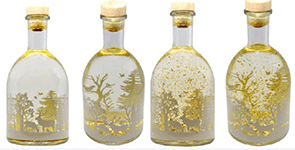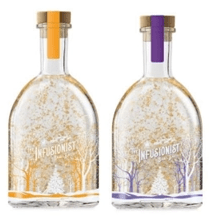What has happened?
- The Court of Appeal has confirmed that the design of Aldi's light up festive gin-based liqueur, sold during Christmas 2021, infringes Marks & Spencer's (M&S's) registered designs for a similar bottle. The legal battle began in 2021 and the latest development follows a High Court decision back in February 2023 that went against Aldi, which Aldi then appealed.
- The High Court had earlier held that the cumulative similarities between Aldi's product and M&S's registered designs was "striking". The Court of Appeal found no reason to interfere with that conclusion.
- It helped M&S that its bottle design was novel, that Aldi's design was close and that there was no reason why Aldi should get so close (there being considerable design freedom for these types of bottles). Where packaging consists of more generic elements – as was partly the case in the recent Thatcher's v Aldi case (which Aldi won) - then the outcome might be different.
- The case illustrates the potential benefits of having an 'arsenal' of IP rights (including registered trade marks and designs) in place for products and packaging.
- The case is also significant in that it clarifies a number of areas of design law that were somewhat unclear. In particular, the Court held that products manufactured to a registered design and product indications can be used to help resolve any ambiguities as to what is shown in a design image.
-
In addition, designs disclosed by the design owner during the 12-month grace period are to be excluded when assessing infringement (as well as validity) of the registered design. However, only disclosures of the registered design and any designs which do not produce a different overall impression are so excluded.
The considerable implications of this are considered separately at the end of this article.
Want to know more?
What was the dispute about?
M&S launched its gin-based liqueur range in autumn 2020. The bottles are festively decorated, and the liqueur contains edible gold flakes which become suspended in the liquid (like a snow globe) when the bottle is shaken. The base of the bottle contains an LED light which, when turned on, illuminates the contents of the bottle.
The design of these bottles is protected by M&S by UK registered designs, four of which (depicted below) were relevant by the time of the appeal. The registration date for each is 29 April 2021 (with an unchallenged priority date of 15 December 2020).

In November 2021, Aldi started to sell gin liqueurs containing gold flakes in a festive light-up bottle (also depicted below).

There are clear similarities between Aldi's product and M&S's registered designs – the botanical shaped clear bottle, stopper, winter scene (mainly consisting of tree silhouettes) on the entirety of the straight sides of the bottle, a gold snow effect, and an integrated LED light in the base of the bottle. The High Court described the similarities as "striking".
Did M&S's design registrations disclose a clear bottle/liquid and integrated lights?
There were questions as what features the photographs forming M&S's registered designs disclosed. Importantly, the designs are much clearer when viewed on the online UKIPO database and the Court took the opportunity to view them there.
The Court concluded that it is "tolerably clear" from inspection of the images that UK 82 and 84 show a clear bottle and clear liquid photographed against a blue background (and not a blue bottle and/or blue liquid) and that UK 78 and 80 show an integrated light.
This conclusion was confirmed by M&S's actual products, the Court saying that the High Court had been wrong to hold that products manufactured to the design are "irrelevant to interpretation of the design". The ECJ has previously held that they can be taken into account, certainly to "confirm the conclusions already drawn". The Court did so here.
Likewise, the "indication of product" on the register (here the product was indicated to be a "Light Up Gin Bottle") "can be relied on to resolve an ambiguity as to what is shown in the image, and in that sense to assist in the interpretation of the design". The rationale is that "If a third party is searching the register for designs of bottles incorporating a light, they may be uncertain purely from inspecting the images in the Registered Designs whether they depict such a light. If so, the statement that the product to which the designs are intended to be applied is a “light up gin bottle” provides an unambiguous answer to the question." The Court came to this view despite conflicting authorities and Article 36 of the Community Design Regulation (which says that a product indication "shall not affect the scope of protection as such").
Are disclosures by design owners relevant for infringement?
Design owners are accorded a 12-month grace period in which they (or any successor in title) may disclose their design without such disclosure being considered relevant to the novelty or individual character of the design when registered. This allows designers to test their designs (and variations of them) on the market before committing to a design(s) to register (without affecting the validity of the subsequent registration).
However, there is no corresponding provision in the legislation relating to infringement. (A registered design is infringed if the alleged infringement does not produce a different overall impression compared to the design registered on the informed user, bearing in mind any designs already disclosed to the public before the relevant date.)
The Court held that the legislature could not have intended disclosures by the design owner to be excluded for validity but not infringement. Had the Court found otherwise, this would have substantially restricted the benefit of the grace period to design owners especially as a tool for testing the water with different designs. This was important because the product M&S originally launched was different to that it subsequently registered.
What disclosures are excluded for infringement?
Having concluded that disclosures by design owners during the grace period are excluded for infringement as well as validity, the Court went on to consider what disclosures are excluded. The options were (that the following are excluded):
- Only designs that are the same as that subsequently registered.
- Disclosures of the registered design and any designs which do not produce a different overall impression to that of the registered design.
Having considered various sources (including textbooks), the Court held that the middle option was correct (by analogy the same must be true for validity). The first option was too restrictive and the last too generous.
This means that brand owners who are using similar designs (or parts of designs) for multiple products should consider the effect of that on any possible future infringement actions. Had M&S, for example, produced, let's say, a differently shaped bottle containing, an integrated light, stopper and snow globe effect (which produced a different overall impression to that of the registered designs in question here), this could have impacted the assessment of infringement and the uniqueness of M&S registered designs.
What's the impact of the priority date?
The Court confirmed that, where there is a valid priority date (as here), the grace period extends back 12 months from that priority date and that the comparison of overall impression (for validity and infringement) is undertaken as at the priority date or, if there is not one, the filing date.
The decision makes clear that a design can only make a single overall impression (which is the same for validity as for infringement).
What does this decision mean for you?
- The case shows the potential benefit of having an arsenal of different IP rights in place for products and packaging. Design registrations are not only cheaper and easier to obtain than trade mark registrations but have potential advantages when alleging infringement. For example, the informed user (design law) is deemed to be more observant than the average consumer (trade mark law).
- What's appropriate in each case will vary and specific advice should be sought, including if and when a potentially infringing product is identified (at which point, IP protection can potentially be bolstered).
- It is hard to image how M&S could have photographed its bottle design more clearly given the technical constraints of showing features such as integrated lights and snow globe type effects. Nonetheless, the decision illustrates the importance of carefully photographing and depicting designs as they will be picked over by potential defendants to infringement actions.
- Fortunately, the case confirms that products manufactured to the design and product indications can be used to help resolve any ambiguities in the image. Brands owners should carefully consider whether they wish to use product indications.
- Care should also be taken when testing out different designs or using similar designs (or design elements) for different products on the market. Those designs could form part of the design corpus (when assessing infringement) if they produce a different overall impression on the informed user to the registered design alleged to be infringed – potentially narrowing the scope of protection of the registration.






